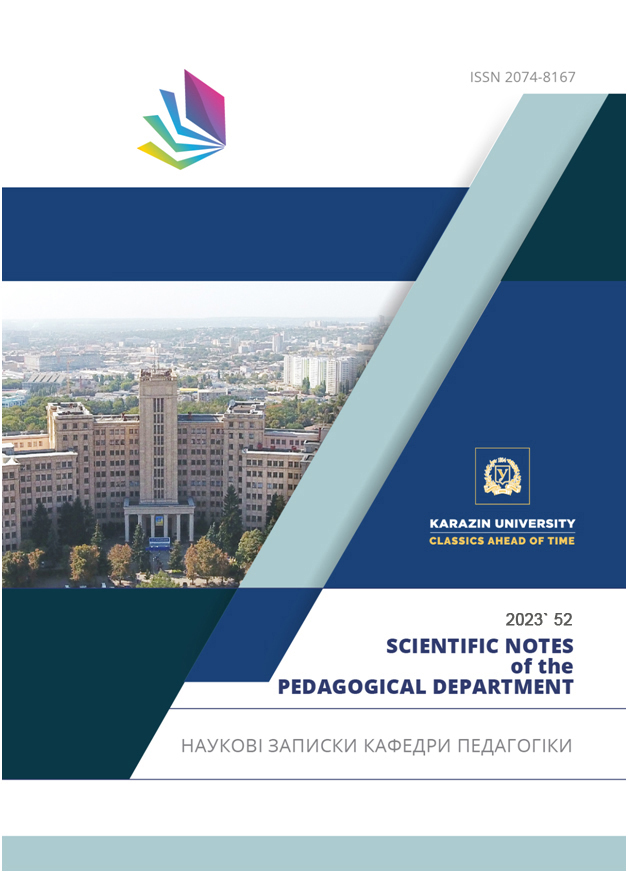Education system and labor market: interdependence issues
Abstract
Formulation of the problem. The labor market has recently undergone significant changes under the influence of many factors. Among them are globalization, demographic, migration processes, international conflicts and wars, climate change, epidemics, etc. Digitalization and green transit are becoming especially relevant in all spheres of life. This affects the requirements for knowledge and skills of employers who are preparing to receive or change jobs. Therefore, the field of education faces an important task of introducing flexible and effective educational programs.
The purpose of the article. To summarize statistical and analythical information and forecasts regarding changes in education in European countries and Ukraine in the context of the transformation of labor market and under the influence of the deployment of industry 4.0.
The main results of the study. The article notes the growth of unemployment among young people on the European continent, which began in the early 1960s. Statistics on education and the unemployment rate in Ukraine, damages from the war that was unleashed by Russia in 2022 are given. The growing role of institutions is especially emphasized professional education and training in the general education system of the countries of the world, blurring the boundaries between secondary special and higher education. Two main trends are highlighted in education: the development of information and communication technologies and increasing the role of transversal skills. Statistics on the level of basic digital skills among citizens of EU member states and initiatives to increase the digital literacy of Europeans are given. The presence of different approaches to the ratio of general theoretical and professional disciplines in different national education systems is emphasized.
Conclusions. The impact on the sphere of education and the labor market of the process of automation, robotization, and the transition to a green economy remains to be determined. The perspective of introducing integrated approaches in education such as the German "learning fields" (Lernfelder) or the professional "code" in the Finnish system is indicated.
Downloads
References
Lugovyi, V.I. (2020). The current state of higher education in Ukraine: problems, reasons, prospects. Bulletin of NAPNU, 2(2). URL: https://doi.org/10.37472/2707-305X-2020-2-2-11-2 (Last accessed: 04.10.2022) [in Ukrainian].
Mospan, N. (2018). Higher education and the labor market of the European Union: trends interaction: edited by S.O. Sysoeva K.: VP «Edelweiss». 392 p. [in Ukrainian].
Khomenko, M. (2021) M. Khomenko: the labor market and the market of educational services. Osvita.ua 09/14/2021. URL: https://osvita.ua/blogs/84239/ (Date of access: 04/12/2023) (Last accessed: 12.04.2023) [in Ukrainian].
Binder, K. (2023) Progress on the European Commission’s 2021-2027 digital education action plan. EPRS European Parliamentary Research Service. March 2023. URL.: https://www.europarl.europa.eu/RegData/etudes/BRIE/2023/745689/EPRS_BRI(2023)745689_EN.pdf (Last accessed: 25.03.2023).
Cedefop (2022). The future of vocational education and training in Europe. Volume 1: the changing content and profile of VET: epistemological challenges and opportunities. Luxembourg: Publications Office of the European Union. Cedefop research paper; No 83. 132 pp. URL: http://data.europa.eu/doi/10.2801/215705 (Last accessed: 05.04.2023).
Cedefop (2022). The future of vocational education and training in Europe. Volume 2: delivering IVET: institutional diversification and/or expansion? Luxembourg: Publications Office. Cedefop research paper, No 84.114 pp. URL: http://data.europa.eu/doi/10.2801/780431 (Last accessed: 11.04.2023).
Cedefop (2004). Towards a history of vocational education and training (VET) in Europe in a comparative perspective. Vol. 2. Luxembourg: Office for Official Publications of the European Union, 109 pp. URL.: https://www.cedefop.europa.eu/files/5153_2_en.pdf (Last accessed: 10.04.2023).
Council of the European Union (2018). Council Recommendation of 22 May 2018 on key competences for lifelong learning (Text with EEA relevance) (2018/C 189/01) URL.: https://eur-lex.europa.eu/legal-content/EN/TXT/PDF/?uri=CELEX:32018H0604(01)&rid=7 (Last accessed: 23.03.2023).
European Commission (2020). Communication from the Commission to the European Parliament, the Council, the European Economic and Social Committee and the Committee of the Regions. Digital Education Action Plan 2021-2027 Resetting education and training for the digital age. {SWD (2020) 209 final}. Brussels, 30.9.2020 COM (2020) 624 final. URL: https://eur-lex.europa.eu/legal-content/EN/TXT/PDF/?uri=CELEX:52020DC0624&from=EN (Last accessed: 05.04.2023).
European Commission (2010). Europe 2020: a strategy for smart, sustainable and inclusive growth. COM (2010) 2020 final. Brussels. 35 pp. URL: https://eurlex.europa.eu/LexUriServ/LexUriServ.do?uri=COM:2010:2020:FIN:EN:PDF (Last accessed: 03.04.2023).
European Commission (1994). Growth, competitiveness, employment: the challenges and the ways forward into the 21st century. COM (93) 700. Luxembourg: Office for Official Publications of the European Communities.167 pp. URL: https://op.europa.eu/en/publication-detail/-/publication/4e6ecfb6-471e-4108-9c7d-90cb1c3096af/language-en (Last accessed: 02.04.2023).
European Council conclusions, 23-24 June 2022. URL: https://www.consilium.europa.eu/media/57442/2022-06-2324-euco-conclusions-en.pdf (Last accessed: 04.04.2023).
Eurostat (9 March 2023). Annual inflation more than tripled in the EU in 2022. URL: https://ec.europa.eu/eurostat/web/products-eurostat-news/w/ddn-20230309-2 (Last accessed: 12.04.2023).
Eurostat (31 March 2023). Euro area unemployment at 6.6%. URL: https://ec.europa.eu/eurostat/documents/2995521/16324762/3-31032023-BP-EN.pdf/4cb7a93a-bb55-923d-ec95-5fcb8073271c (Last accessed: 15.04.2023).
Eurostat (7 March 2023). Share of individuals having at least basic digital skills, by sex. URL: https://ec.europa.eu/eurostat/databrowser/view/SDG_04_70__custom_4713299/default/table?lang=en (Last accessed: 05.04.2023).
ILO (March 2023). World Employment and Social Outlook 2023: The value of essential work URL: https://www.ilo.org/digitalguides/en-gb/story/weso2023-key-workers#chapter1-definition (Last accessed: 09.04.2023).
Markowitsch, J., Hefler, G. (2019). Future Developments in Vocational Education and Training in Europe: Report on reskilling and upskilling through formal and vocational education training, Seville: European Commission, JRC 117691. 24 pp.
Ministry of Education and Science of Ukraine (2023). Overview of the current state of education and science in Ukraine in terms of russian aggression (as of January 2023). URL: https://reliefweb.int/report/ukraine/overview-current-state-education-and-science-ukraine-terms-russian-aggression-january-2023-enuk (Last accessed: 12.04.2023).
Pouliakas, K. (2018). Determinants of automation risk in the EU labour market: a skills-needs approach. IZA Discussion Paper, No 11829. 28 pp. URL.: https://www.iza.org/publications/dp/11829/determinants-ofautomation-riskin-the-eu-labour-market-a-skills-needs-approach (Last accessed: 03.04.2023).
These professions are in the highest growing demand in Europe (4 April 2023). The Brussels Times. 4 April 2023. URL: https://www.brusselstimes.com/440849/these-professions-are-in-the-highest-growing-demandin-europe (Last accessed: 17.04.2023).

